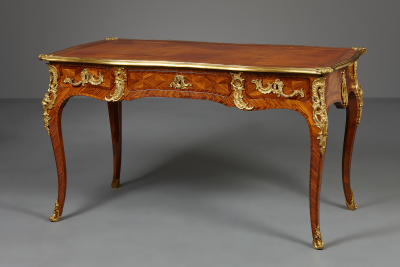French Louis XV bureau plat, stamped Migeon
French Louis XV bureau plat, stamped Migeon
A writing table with gently undulating, arched lines reflected in the legs as well as the apron and the contours of the tabletop. The undulations are emphasised by the fire-gilt bronzework, which serves to enhance the table’s silhouette as well as to protect it.
On the writing side, the apron incorporates three drawers; the other side features three false drawers. The shapes of the drawers are also reflected in the side aprons, reinterpreted as parquetry fields. The upper sides of these fields are straight, while their lower edges follow the apron’s undulant lines. The fields around the drawers and false drawers, which continue into the table’s legs, are decorated with a diagonal linear pattern using kingwood.
The fire-gilt bronzework on this writing table comprises six drawer pulls with attractive asymmetrical shapes. Each drawer also features a key plate. Between the drawers and false drawers are fire-gilt bronze ornaments consisting of acanthus leaf-shaped volutes that emphasise the lines of the fields. The bronzework at the table’s corners consists of openwork volutes and acanthus leaves. The surfaces at the sides of the table are similarly decorated with bronzework between the parquetry fields. The writing panel, which has a slightly wave-like form, is rimmed with a profiled fire-gilt bronze frame with floral-patterned bronzework at the corners, within which is a kingwood passe-partout enclosing the writing panel.
Writing tables were meant to be placed in the middle of a room. They were used to work at, but also to receive guests: business could be conducted across the table, and both parties could use the writing surface at once. Due to their central placement in a room, such tables had to be handsomely finished and decorated on all sides, unlike desks that were placed against walls and therefore needed no decoration on their wall-facing rear sides.
Pierre II Migeon (1701-1758) belonged to one of the most prominent protestant ébéniste families in Paris. His father, Pierre Migeon I (born ca. 1670), established a flourishing company that catered to noble and royal customers. Pierre Migeon II’s career began around 1726, although he was never registered as maître-ébéniste. This was likely because his strict Calvinist faith prohibited membership of guilds unless one obtained special dispensation. However, we know that by 1739 he had already been made head of his father’s workshop and furniture imperium on Rue de Charenton in the Faubourg Saint-Antoine. The firm’s daybook from 1730-1736 reveals an exceptionally prosperous business whose clientele the dowager Duchess de Bourbon, the Duke of Orleans, the son of the regent, and the Duchess de Rohan.
Migeon was not only an ébéniste but also a dealer, which would account for the large number of pieces that bear his mark. His suppliers consisted of the very best craftsmen of the age, such as Boudin, Dautriche, R.V.L.C., Duval, Criaerd, Bircklé, Macret, Topino and so on. Despite his many suppliers, pieces bearing Migeon’s stamp display a remarkable stylistic uniformity. His designs were restrained and never excessively rococo, although his works do reveal a preference for sinuous and sometimes bulky shapes, as exemplified by his commodes en tombeaux and low secretary desks. His veneer tended to incorporate geometric patterns, often using dark woods such as kingwood or tulipwood, as well as floral decorative cartouches. He was likely the first ébéniste to use mahogany veneer. Pierre II Migeon’s specialties included secretary desks, commodes, writing tables and small but elaborate pieces, such as the luxurious water closets that he supplied to the ladies of the court and Madame de Pompadour.
From 1740 on, Migeon supplied the court through the offices of the Menus Plaisirs and also provided various functional pieces to the Garde-Meuble Royal, who were responsible for the furnishing of the royal palaces. After Pierre II’s sudden death, his son Pierre III Migeon (1733-75, made master in 1761) took over the prosperous business and managed it until his own death. After that, the company was headed by his widow until approximately 1785. The works of all family members are of exceptional quality. Works by Pierre Migeon II are on display in the Musée des Arts Décoratifs, the Louvre, the Petit Palais and the Carnavalet in Paris, in the Palaces of Fontainebleau and Champs-sur-Marne, as well as in Musée des Arts Décoratifs in Lyon and in Beauvais. Pieces by his hand also feature in the collections of the Victoria & Albert Museum and the Wallace Collection, Waddesdon Manor, the National Gallery of Art in Washington, D.C. and the Residenzmuseum in Munich.
- Provenance
- Nijstad Sculptuur & Glas BV, Amsterdam
Dutch private collection, purchased from the above on 19 August 1980 - Period
- ca. 1740
- Material
- oak and softwood core, veneered with tulipwood and kingwood, leather writing panel, fire-gilt bronzework
- Signature
- Migeon
- Dimensions
- 74 x 131 x 75 cm
Global shipping available










